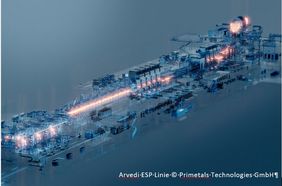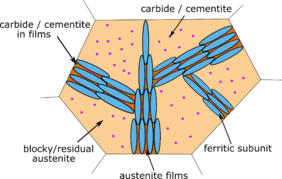TRIP (Transformation-Induced Plasticity) steels are special high-strength grades with high ductility which, thanks to their high energy absorption capacity, are used in crash-relevant components in the automotive sector.
TRIP steels are typically produced in multiple processing steps, including slab casting, reheating, hot rolling, cold rolling and annealing. In contrast to this extensive processing, new strategies for producing hot-rolled TRIP steels for direct application using Endless Strip production (ESP) offer major energy and cost savings.
Another advantage, in addition to energy and cost savings, is that unlike conventional hot strip production and other direct casting and rolling concepts, the Arvedi-ESP process does not generate any significant direct CO2 emissions.
The main requirement for casting TRIP steels on thin slab casters is to avoid a peritectic solidification reaction. This is mandatory for the high casting speeds necessary for endless production.
With the help of sophisticated comprehensive simulation tools covering both the casting and the rolling/cooling part of the ESP line, TRIP steels with dedicated compositions were derived using through-process computer models. These newly developed types feature both proper castability as well as the necessary processing stability in the rolling/cooling part of the ESP line.
The ESP route for hot rolled TRIP steel consists of the material passing through the finishing mill in the austenitic state after casting and roughing. The strip is cooled to an intermediate temperature and held there isothermally for a few seconds to obtain the desired ferrite phase fraction on the laminar cooling line.
In a second cooling step right in front of the coiler the strip is finally quenched to temperatures around 350°C, where most of the remaining austenite starts to transform into bainitic ferrite. This bainitic ferrite stabilizes the remaining metastable film-like austenite microstructure surrounding it by expelling its excess carbon, see Fig. 1.
The final microstructure after coil cooling then consists of ferrite, ferritic bainite and retained austenite. During deformation, for example in a car crash, the retained austenite then transforms into the strong phase martensite while consuming the crash energy during plastic deformation.
Impact
These new computer-assisted methods strongly accelerate the development of highly advanced value-added steel grades via the energy-efficient and environmentally-friendly ESP technology. In this way, the attractiveness of ESP as the leading direct casting and rolling technology is increased further.
Project coordination (Story)
Dr. Simon Großeiber
Primetals Technologies Austria GmbH
T +43 664 6150586
simon.grosseiber(at)primetals.com
Project partners
• Montanuniversität Leoben, Austria
• TU Wien, Austria
• Primetals Technologies Austria GmbH, Austria
• RHI Magnesita GmbH, Austria




















